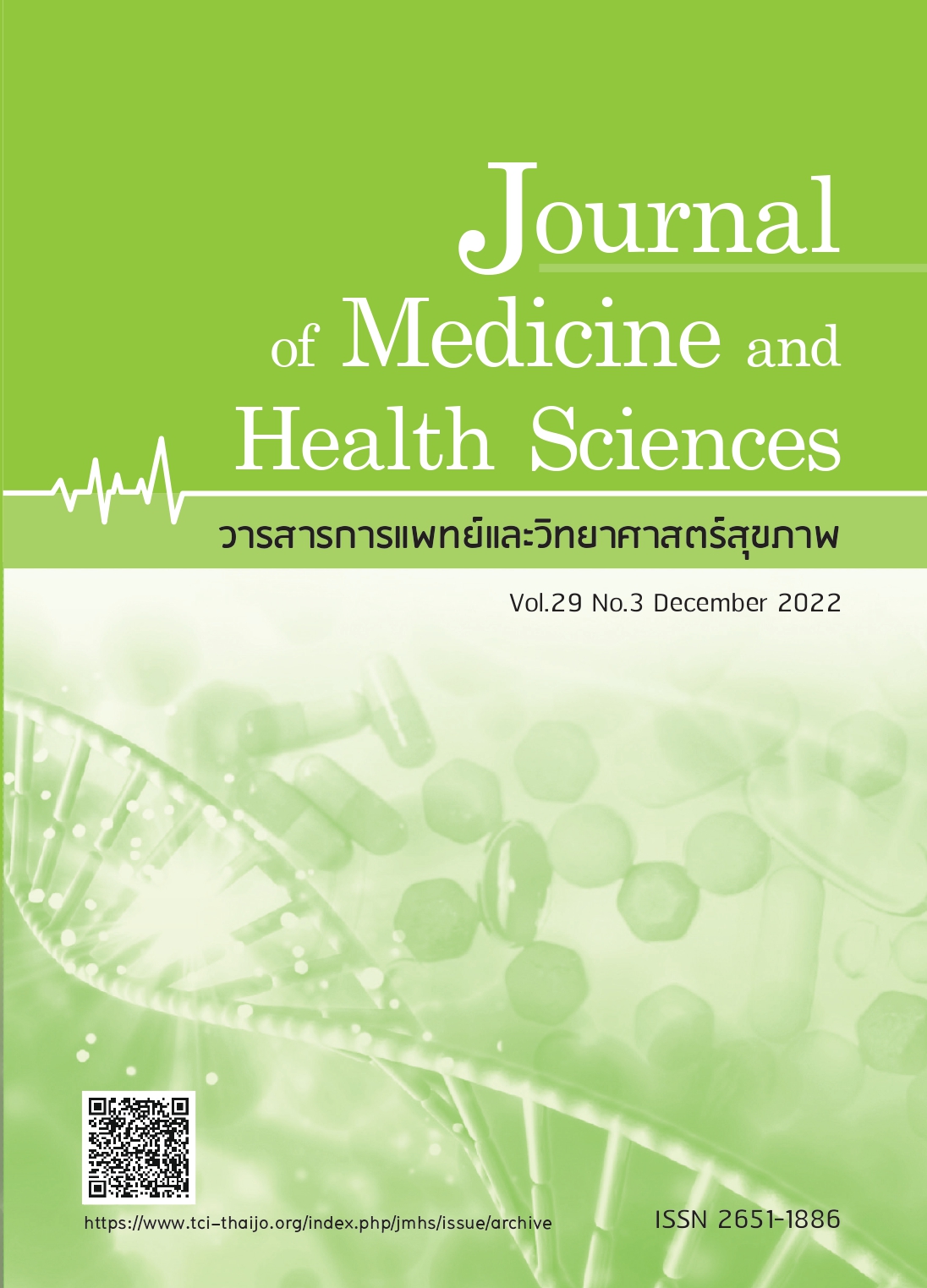Efficacy of tranexamic acid for reducing blood loss after caesarean section on women with previous caesarean sections: A randomized controlled trial
Keywords:
Tranexamic acid, Caesarean section, Previous caesarean section, Randomized controlled trialAbstract
Abstract
Postpartum hemorrhage is the most common obstetric complication, especially in the case of a caesarean section. International studies have shown that tranexamic acid is effective in preventing blood loss during and after caesarean section. This study aims to examine efficacy of tranexamic acid for reducing blood loss following a caesarean section. A double-blind randomized and controlled trial method was employed in this study. The sample consisted of pregnant women who had previously received a caaesarean section. The students were divided into experimental and control groups, with 36 students per group. The experimental group received 1g of tranexamic acid and the control group received 9.0% NSS 20ml. The primary outcomes compared mean blood loss, and hematocrit volume after birth. The secondary outcomes were to examine the incidence of postpartum haemorrhage, and adverse events. The statistics were analyzed using chi square test and an independent t-test and there were no statistical differences in terms of age, number of pregnancies, parity, gestational age, maternal weight and height, hematocrit, birth weight and duration of caesarean section in both groups. The mean blood loss was significantly lower in the experimental group than the control group (740.58 ± 139.57 and 853.53 ± 163.67, p = 0.002). ). The mean haematocrit was significantly higher in the experimental group than the control group (35.50 ± 3.29 and 33.92 ± 3.03, p 0.037). ). The incidence of postpartum haemorrhage was significantly lower in the experimental group than the control group (5.56%, 25.00, p = .046.0). There were no statistical differences in the adverse events of both groups. In conclusion, 1 mg of tranexamic acid was effective for reducing blood loss and the incidence of postpartum hemorrhage in women with a previous caesarean section.
References
Stortroen EN, Tubog TD, Shaffer SK. Prophylactic Tranexamic acid in high-risk patients undergoing cesarean delivery: A
systematic review and meta-analysis of randomized controlled trials. AANA J 2020;88:272-81.
Royal college of obstetricians and gynecologists of Thailand. Clinical practice guideline prevention and management of postpartum hemorrhage [Internet]. 2020. [cited 2021 Sep 10]. Available from http:// www.rtcog.or.th/home/wp-content uploads/
/09/OB-63-020-Prevention-andmanagement-of-postpartum-hemorrhage.pdf.
ACOG Practice bulletin. Clinical management guidelines for obstetrician-gynecologists number 76, october 2006: postpartum hemorrhage. Obstet Gynecol 2006;108: 1039-47.
Sheldon WR, Blum J, Vogel JP, et al. WHO multicountry survey on maternal and newborn health research network. Postpartum haemorrhage management, risks, and maternal outcomes: findings from the World Health Organization multicountry survey on maternal and newborn health. BJOG 2004;121:5-13.
World Health Organization. Trends in maternal mortality: 2000 to 2017: Estimates by WHO, UNICEF, UNFPA, World bank group and the united nations population division, Geneva, Switzerland; 2019.
Department of Health Ministry of Public Health. Situation analysis of Thai maternal mortality in the first 6 months [Internet]. 2021. [cited 2021 Oct 25]. Available from https://hp.anamai.moph.go.th/webupload/4xceb3b571ddb70741ad132d 75876bc41d/tinymce/OPDC/ OPDC2564-S/IDC1_6/opdc_2564_IDC1-6_02.pdf.
Thongsong T, Sirichotiyakul S. Postpartum hemorrhage in: Obstetrics Thongsong T 5th rev. ed. Bangkok: Luxameerung Co., Ltd; 2012.
Belfort et al, 2020;
Lim PS. Uterine Atony: Management strategies. [Internet]. 2012. [cited 2021 Oct 25]. Available from www.intechopen.com.
Filho RE, Costa ML, Cecatti JG, et al. Severe maternal morbidity and near miss due to postpartum hemorrhage in a national multicenter surveillance study. Int J Gynaecol Obstet 2015;128:131-6.
Esteves-Pereira AP, Deneux-Tharaux C, Nakamura-Pereira M, et al. Caesarean delivery and postpartum maternal mortality: A population-based case control study in Brazil. PLOS ONE 2016;11: e0153396.
Vincent C, Neale G, Woloshynowych M. Adverse events in British hospitals. BMJ 2001;322:517-9.
Anderson JM. Prevention and management of postpartum hemorrhage. Am Fam Physician 2007;75:875-82.
Acharya G, Al-Sammarai MT, Patel N, et al. A randomized controlled trial comparing effect of oral misoprostol and intravenous syntocinon on intra-operative blood loss during cesarean section. Acta Obstet Gynecol Scand 2001;80:245-50.
World Health Organization. WHO recommendation on tranexamic acid for the treatment of postpartum haemorrhage. Geneva: World Health Organization. Licence: CC BY-NC-SA 3.0 IGO; 2017.
Li C, Gong Y, Dong L, et al. Is prophylactic tranexamic acid administration effective and safe for postpar tum hemorrhage prevention? A systematic review and meta-analysis. Medicine (Baltimore) 2016;96:e5653.
Lakshmi SJ, AbRaham R. Role of prophylactic tranexamic acid in reducing blood loss during elective caesarean
section: A randomized controlled study. J Clin Diagn Res 2016;10:QC17-21.
Obi VO, Umeora OU, Dimejesi IB, et al. Efficacy of intravenous tranexamic acid at reducing blood loss during elective caesarean section in Abakaliki: A double blind randomized placebo controlled trial. Afr J Med Health Sci 2019;18:10-7.
Fahmy NG, Eskandar FS, Khalil WA, et al. Assessment the role of tranexamic acid in prevention of postpartum hemorrhage. As J Anesthesiol 2021;13:35.
Rani R, Bano A, Reddy M. Safety profile and efficacy of tranexamic acid on haemorrhage during and after the caesarean section. J Evolution Med Dent Sci 2021;10:222-26.
Sano M, Hakusui H, Kojima C, et al. Absorption and excretion of tranexamic acid following intravenous, intramuscular and oral administrations in healthy volunteers. Jpn J Clin Pharmacol Ther 1976;7:375-82.
Sentilhes L, Daniel V, Deneux-Tharaux C. TRAAP2 - Tranexamic acid for preventing postpartum hemorrhage after cesarean delivery: a multicenter randomized, double blind, placebo- controlled trial - a study protocol. BMC 2020;20:63.
Franchini M, Mengoli C, Cruciani M, et al. Safety and efficacy of tranexamic acid for prevention of obstetric haemorrhage: an updated systematic review and metaanalysis. Blood Transfus 2018;16:329-37.
Novikova N, Hofmeyr GJ, Cluver C. Tranexamic acid for preventing postpartum haemorrhage. Cochrane Database Syst Rev 2015;16:CD007872.
Xia Y, Griffiths BB, Xue Q. Tranexamic acid for postpartum hemorrhage prevention in vaginal delivery: A meta-analysis. Medicine (Baltimore) 2019;3:1-7.
Downloads
Published
How to Cite
Issue
Section
License

This work is licensed under a Creative Commons Attribution-NonCommercial-NoDerivatives 4.0 International License.



